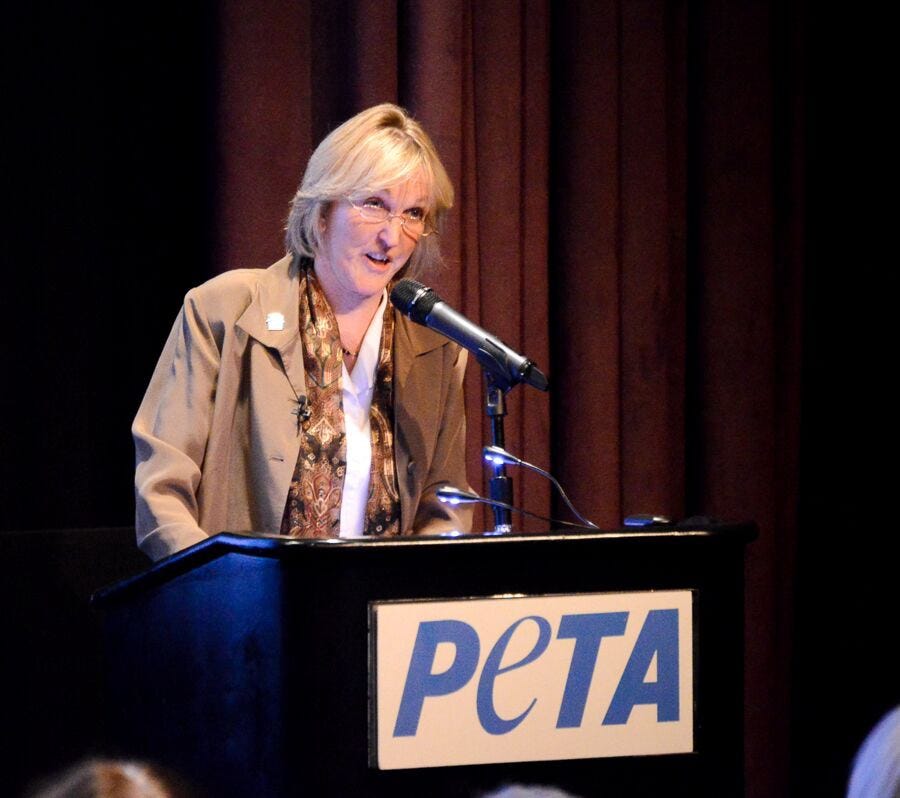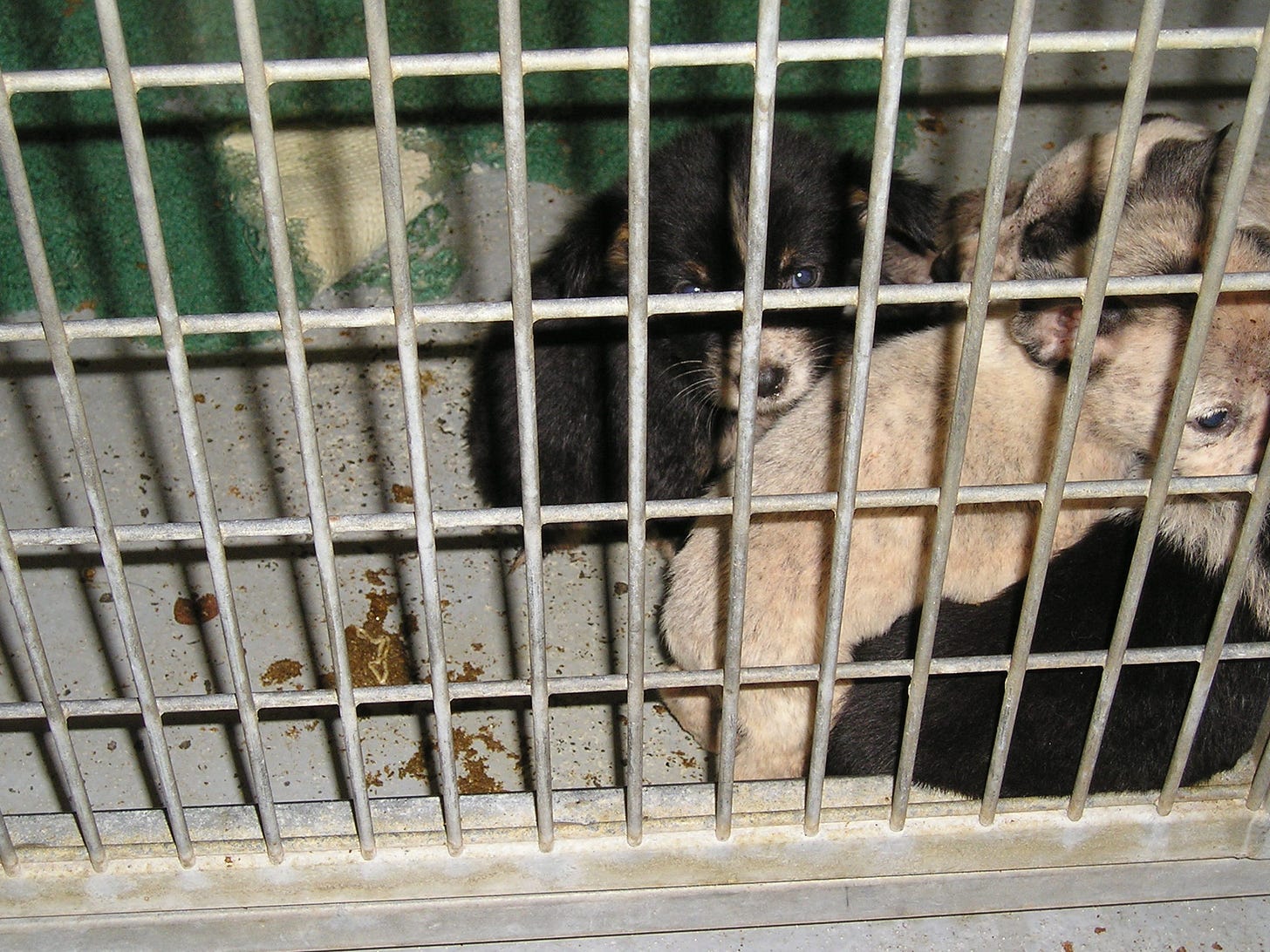Since the 1990s, the No Kill movement has forced tremendous progress upon a resistant and regressive sheltering industry. That progress includes a decline in the national death rate of 90%, fewer people buying animals and more people adopting, an increasing number of cities and even entire states banning the retail sale of commercially-bred animals in pet stores, half of all Nebraska puppy mills shutting down, and towns making it illegal to engage in commercial breeding to protect “the healthful and humane treatment of dogs.”
Because of the No Kill movement, the embrace of the No Kill Equation, and codifying success into law, the United States is on the verge of ending the killing of all but irremediably suffering animals and moving away from breeding dogs in brutal conditions reminiscent of factory farms. But progress is not linear, and continued progress is not inevitable.
The movement faces six dangers that threaten not only to erase the gains of the last three decades but bring about a return to 1970s sheltering norms when:
Dogs and cats were left to fend for themselves on the street;
Neglect and abuse in pounds were rampant;
People were buying, rather than adopting animals; and,
Killing in pounds was standard operating procedure.
These threats are:
Shelters breeding puppies.
Shelters closing their doors to volunteers, rescuers, families looking for lost pets, and adopters.
Neo-racist policies excusing animal cruelty.
Legislation making it easier for pounds to kill animals.
Acting on the belief that animals want to die and killing them is a “gift.”
These proposals are reckless, but, disturbingly, they are coming from “inside the house” – from a handful of corrupt organizations: the Humane Society of the United States, Austin Pets Alive, Best Friends Animal Society, Maddie’s Fund, the ASPCA, and People for the Ethical Treatment of Animals (PETA).
In the podcast above and the article below, I discuss why they are dangerous and what appears to motivate the groups involved. I also discuss the irony of groups embracing the very harms they once falsely accused the No Kill movement of doing – undermining spay/neuter, promoting breeding, turning animals away, increasing neglect and abuse, and sacrificing the quality of adoptive homes.
1. The Humane Society of the United States proposes to have shelters breed puppies.

At their 2022 conference, HSUS workshop presenters will argue that shelters should “start[ ] their own breeding programs” to meet public demand for puppies; a proposal Time magazine calls “a shocking idea, like a cocktail hour at rehab.” But it is more than “shocking.”
It is not only a betrayal of animals and animal advocates but is based on several lies: that we have a severe dog shortage, breeding is the only way to meet demand, purposely-bred dogs make better family pets than shelter dogs, and shelters should cater to “consumer choice,” rather than shape that choice given their mission of animal protection.
What makes it so dangerous?
Non-profit breeding operations will be just as cruel as for-profit commercial breeders, as many of them already are.
Shelters will be killing young, adult, and senior dogs in one part of the shelter, while breeding dogs for sale in another.
It will derail hard-won progress in getting Americans to sterilize and adopt rather than breeding and buying.
It will undermine efforts to ban the sale of commercially-bred animals in pet stores, with half a dozen states and hundreds of cities across the nation already divesting themselves from this pernicious harm and, as a result, half of all Nebraska’s puppy mills shutting down.
Puppy mills will start breeding mixed-breed dogs, too. Indeed, nothing will stop puppy mills from incorporating as non-profits, calling themselves a “humane society” or rescue group, and selling puppies to the public as “adoptions.”
Animal welfare organizations are supposed to model and encourage ethical behavior. In other words, shelters — through adoption — exist to help animals, not the other way around. To the extent that a subset of the American public continues to want puppies, the effort directed at the suggestion that our shelters be turned into commercial breeding operations could be redirected to building the infrastructure necessary to get at-risk puppies in shelters throughout the country and the world to American homes that want them; a win-win.
Tragically, Maddie’s Fund has embraced the breeding proposal. Likewise, Kristen Hassen, an Austin Pets Alive director, shared the idea with a nationwide audience of shelter directors, noting that the “pet shortage” was a “real issue” for her “respected colleagues,” and we “should give them the benefit of the doubt.” We should not. The health, welfare, and lives of animals are at stake.
For further reading: Snatching Defeat from the Jaws of Victory.
2. Austin Pets Alive proposes to have shelters close their doors to lost and homeless animals.

During the pandemic, U.S. animal shelters fell into one of two camps. The first were those who lived up to their mission, stayed open as an essential service, and both met and exceeded their obligations; many having found themselves empty through adoption and fostering for the first time in their history. The second were those who closed their doors, turned animals away, and abandoned the debt and duties they owed animals and residents. These pounds – encouraged by groups like the National Animal Control Association and other regressive organizations – did less work, cared for fewer animals, and all but ceased their adoption programs, even though it meant an increase in animal suffering. As a result, kittens and puppies were left on streets, lost animals were turned away, and people who found animals were told to re-abandon them, including a blind pregnant cat found by one couple walking in circles: “It was just heartbreaking... They told us to release the cat.” Austin Pets Alive wants to make that permanent.
What makes it so dangerous?
The Austin Pets Alive program encourages shelters to close their doors to stray and owner-relinquished animals. In their own words, “Intakes of healthy strays and owner surrenders doesn’t exist anymore,” and there is “No kennel space for rehoming, stray hold or intake.”
In Austin, this included a proposed vision of “not accepting strays at the shelter” to limit intakes and reduce shelter budgets accordingly.
Heeding the advice of Austin Pets Alive, El Paso Animal Services turned away lost and homeless animals, including a little dog with a pink vest and microchip. The person who found her was told to abandon her on the street. He did, and Nesa ended up dead. She would have been reclaimed had the El Paso pound done its job and offered her safe haven. Others will share her fate.
The Austin Pets Alive program is not just a dangerous bait and switch. It is a cynical ploy meant to redefine failure and the abandonment of animals as success and defy the public’s humane expectation that animal shelters have a moral duty to care for the neediest and most vulnerable dogs, cats, and other animal companions in our communities.
To Austin Pets Alive partners, “community sheltering” is a euphemism for no sheltering. That such a retreat should occur at this moment, when the American public has shown itself more enthusiastic and generous in its embrace of animal welfare than ever before, adds to the tragedy of wasted potential inherent to such an approach. Just as our fellow Americans are standing up for animals, Austin Pets Alive would have us stand down.
For further reading: The Co-option of Austin Pets Alive.
3. Best Friends Animal Society proposes to have shelters close their doors to volunteers, rescuers, those looking for lost pets, and adopters without an appointment.

Like Austin Pets Alive, Best Friends Animal Society wants to make pandemic-related closures permanent. Best Friends proposes to close shelter doors to people, including volunteers, rescuers, families looking for lost animals, and adopters unless they make an appointment. Best Friends claims doing so will increase lifesaving (somehow) and reduce animal stress by limiting visitors, activity, and noise levels. For animals, however, visitors mean stimulation, walks, getting played with, and finding homes.
Why is this so dangerous?
The “appointment only” policy reduces the number of people who go to shelters resulting in fewer adoptions, reclaims, and rescues; a death sentence.
It reduces the number of volunteers who go to shelters, reducing socialization. Because animals suffer if not provided “mental and physical stimulation, time out of the kennel and close interaction with people,” more animals will be stressed and either get sick or labeled “kennel crazy”/“aggressive” and killed.
It erases tremendous gains made by the No Kill movement to force greater public access and force better and more sensible adoption and reclaim hours, all of which have been key to reducing shelter killing nationwide.
Public scrutiny keeps neglect and abuse in check. Rescuers, potential adopters, volunteers, and other public members are the community’s heart, eyes, and ears. If they are not allowed to visit the facility unannounced, animals will suffer in silence. That’s not conjecture; it’s history. At the Los Angeles County Department of Animal Care & Control – one of the pounds which has embraced the “appointment-only” policy:
Animals starved to death;
Cats died because they did not get an examination, treatment, or vaccinations;
Animals with torn ears and gouged eyes suffered without rehabilitative care;
Animals cannibalized their kennel mates because they were not fed by staff to the point of starvation; and,
Animals were warehoused in filthy conditions and physically assaulted by staff.
Across the country, public scrutiny has forced regressive shelters to improve. When the public hears about neglect, abuse, and killing in their local shelter, they denounce it and demand changes. It is no surprise then that regressive, historically abusive pound systems like those in Los Angeles and New York would reject accountability by closing their doors to the unannounced public.
For further reading: The Growing Threat of Darkness.
4. Maddie’s Fund and others promote neo-racist voices who excuse animal cruelty.

Maddie’s Fund, Kristen Hassen at Austin Pets Alive, and others promote voices, like Professors Katja Guenther and Andrew Rowan, who undermine animal protection in deference to racist ideas equating people of color with substandard care. Although championed under the guise of increasing diversity and promoting inclusion, these authors and others like them have written books and journal articles that:
Defend dogfighters like Michael Vick, arguing that they should not be prosecuted because they are the real “victims”;
Call for permitting dogs to be left on chains 24 hours a day, seven days a week;
Call for more animals to be killed in pounds or left on the streets instead of rescued and placed in family homes so as not to promote “settler-colonial and racist dynamics of land allocation”; and,
Argue that shelter workers should lower their standards, even when doing so is “at odds with the humane society’s own core beliefs about how animals should be cared for,” including people who do not feed their animals, get necessary medical care for their animals, or engage in dogfighting.
These claims are based on the racist beliefs that viewing animals as family members, letting them sleep in the house, providing medical care, and showing affection are “middle class,” “white” values; while people of color treat animals “as resources, whether protective (as in guarding) or financial (as in breeding or possibly fighting).”
In the wake of the protests over the death of George Floyd, organizations across the country looked for ways to express solidarity with the cause of civil rights, and animal welfare groups are no exception. But we should not confuse these racist tropes and cruel policies with the cause of animal protection (or human dignity).
Some ways of relating to animals are better than others. Determining which starts with objective norms rooted in the animal’s biology and Enlightenment values, including the inalienable rights to life, liberty, and the pursuit of happiness. For example, feeding them nutritious food regularly, allowing them to sleep in the house, providing prompt and necessary veterinary care, and showing tenderness and love are ways of relating to animals that increase the well-being of dogs and cats and should be afforded to all of them, irrespective of the ethnicity or race of the human with whom they live. Arguing otherwise isn't animal advocacy; it is the antithesis.
For further reading, The Racism of Low Expectations and its Deadly Consequences for Animals.
5. The ASPCA is trying to pass laws making it easier for pounds to kill animals quickly.

It’s been over 20 years since the achievement of the nation’s first No Kill community, and, with it, creation of the model that provides high-quality care and allows any shelter to replace killing with humane alternatives. And while hundreds of shelters across the nation have already embraced the No Kill philosophy and the No Kill Equation that makes it possible – saving millions of animals in the process – there are still too many animals suffering and dying in shelters that have yet to do so.
Given this – and given all the threats to current and continued No Kill success – laws are needed to mandate how shelters operate. These laws would:
Eliminate the discretion that allows managers and staff to avoid doing what is in the best interest of animals;
Require protocols that improve animal welfare through clean, hygienic, and enriched environments; and,
Result in placement rates of 98% - 99%, returning killing to its dictionary definition: an act of mercy for irremediably suffering animals only.
But the ASPCA is standing in the way.
For example:
The Shelter Animal Rescue Act, written by The No Kill Advocacy Center, would make it illegal for any New York pound to kill a healthy or treatable animal if a qualified non-profit organization is willing to save that animal. Although modeled after successful legislation in other cities and states that save hundreds of thousands of animals every year, the ASPCA has blocked the legislation from becoming law in New York and has done so every year since 2010, putting an estimated 300,000 animals into an early grave.
2. Instead, the ASPCA seeks legislation that will result in fewer animals making it out of those facilities alive. In addition to making it harder for non-profit rescue organizations to save animals, ASPCA bills create a new justification for killing: “mental suffering.” There is no definition of what constitutes “mental suffering” and no standards for applying it. The proposed legislation allows pounds to kill animals based on an animal’s perceived state of mind and often with no holding period of any kind.
Given that they find their familiar routines upended in a confined place that is loud, often dirty, unfamiliar, disorienting, and hostile, all animals can experience stress on entry to a pound. As such, the ASPCA legislation is not only a real and immediate threat to shy and scared animals, as well as feral cats, but it is a first-of-its-kind, dangerous precedent to introduce in the animal control laws of our nation.
As progressive shelters have demonstrated and peer-reviewed studies have confirmed, most animals classified as having “behavior” issues in pounds are perfectly normal. In addition to co-housing with other animals, socialization, and exercise, simply getting them out of the shelter through adoption, rescue, or foster care would resolve most perceived issues relating to “mental suffering.” Unfortunately, ASPCA bills mandate none of these, and the organization often opposes these common-sense reforms.
For further reading: From the Arms of Angel.
6. PETA believes animals want to die and killing them is a “gift.”

PETA has killed over 40,000 animals, including young, healthy cats, kittens, and puppies, most without making them available for adoption. But the number may be many times higher – a whistleblower who worked for PETA was told to lie and kill animals without reporting it.
Why do they kill? Employees report that they are made to watch “heart-wrenching” films about animal abuse designed to instill the belief that people are incapable of caring for animals and that “PETA was doing what was best for animals” by killing them. On the one hand, PETA leadership instructs employees that people don’t, can’t, and won’t take care of animals, leading to suffering through neglect and abuse. On the other hand, they also argue that animals cannot live without human care, requiring PETA to round them up. The animals are damned either way, and thus, killing them is a “gift.”
To Ingrid Newkirk, killing is the goal because she believes animals want to die. It is, she writes, the “greatest gift of all”; a mindset in which she schools her staff, who then argue, as she does, that killing healthy animal companions is not only morally acceptable, it is morally required.
The result: The arrest of PETA employees and representatives for stealing and killing animals or acquiring them under false pretenses by promising to find them homes only to kill them within minutes in the back of a van, a donor-funded slaughterhouse on wheels. Upwards of 99% of all animals PETA acquires lose their lives (or displace others who are killed). When a movement takes direction from an organization that is itself the functional equivalent of a slaughterhouse, it can’t help but get it pathologically wrong.
For further reading: The Theft and Killing of Maya and Why PETA Kills.
The future is not yet written.
There was a time when No Kill was just a dream. We dreamed it anyway. And because we did, it no longer is. We now have a solution to shelter killing, and it is not difficult, expensive, or beyond practical means to achieve. Thanks to the No Kill Equation, millions of people now live in No Kill communities that place over 99% of all animals entrusted to their care.
We can make pound killing a thing of the past in every American community. We can end the neglect and abuse that is the natural outcome of breeding animal companions for the pet trade. We can turn our shelters into safe havens. And we can build upon those successes to protect other animals, no matter the species, no matter the threat of harm.
To achieve this vision, we need only do what we have always done, what our success thus far has been dependent upon — to neither accept nor emulate the voices of defeatism, of corruption, of those who believe in their own celebrity and put themselves and the dystopian visions of their organizations above the needs and lives of animals.
We must continue to march forward…











